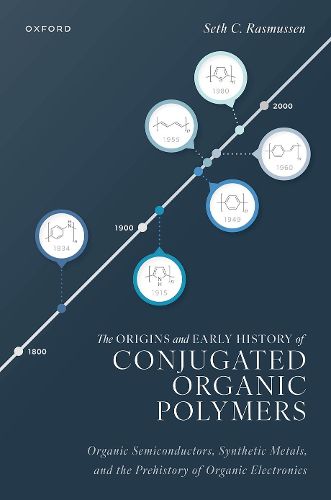Readings Newsletter
Become a Readings Member to make your shopping experience even easier.
Sign in or sign up for free!
You’re not far away from qualifying for FREE standard shipping within Australia
You’ve qualified for FREE standard shipping within Australia
The cart is loading…






Conjugated organic polymers first drew significant interest in the late 1970s when metallic-looking plastic films of polyacetylene were shown to exhibit conductivities in the metallic regime after treatment with various oxidizing agents. These results formed the basis for awarding Alan MacDiarmid, Alan Heeger, and Hideki Shirakawa the 2000 Nobel Prize in Chemistry for the "for the discovery and development of electrically conductive polymers." However, reports of electrically conductive polymers date back to the early 1960s, with the study of conjugated polymers as a whole dating back to the early 19th century.
The Origins and Early History of Conjugated Organic Polymers rethinks the accepted historical narrative of conjugated organic polymers, challenges the established interpretations, and provides new insights into these fascinating electronic materials. Using a range of reader-friendly figures, tables, and illustrations, this book charts the history of the first six primary parent polymers, beginning with the introduction of polyaniline in 1834 and continuing up through the development of polythiophenes and low bandgap polymers in the 1980s.
Thought-provoking and original, The Origins and Early History of Conjugated Organic Polymers presents an authoritative history of the primary conjugated organic materials that now make up the foundations of a significant field of science and technology.
$9.00 standard shipping within Australia
FREE standard shipping within Australia for orders over $100.00
Express & International shipping calculated at checkout
Conjugated organic polymers first drew significant interest in the late 1970s when metallic-looking plastic films of polyacetylene were shown to exhibit conductivities in the metallic regime after treatment with various oxidizing agents. These results formed the basis for awarding Alan MacDiarmid, Alan Heeger, and Hideki Shirakawa the 2000 Nobel Prize in Chemistry for the "for the discovery and development of electrically conductive polymers." However, reports of electrically conductive polymers date back to the early 1960s, with the study of conjugated polymers as a whole dating back to the early 19th century.
The Origins and Early History of Conjugated Organic Polymers rethinks the accepted historical narrative of conjugated organic polymers, challenges the established interpretations, and provides new insights into these fascinating electronic materials. Using a range of reader-friendly figures, tables, and illustrations, this book charts the history of the first six primary parent polymers, beginning with the introduction of polyaniline in 1834 and continuing up through the development of polythiophenes and low bandgap polymers in the 1980s.
Thought-provoking and original, The Origins and Early History of Conjugated Organic Polymers presents an authoritative history of the primary conjugated organic materials that now make up the foundations of a significant field of science and technology.